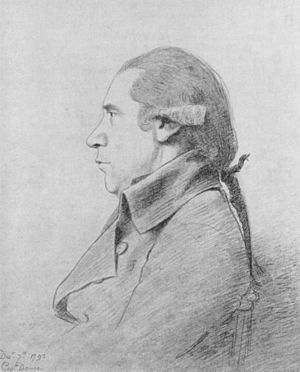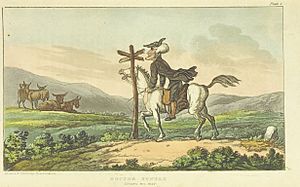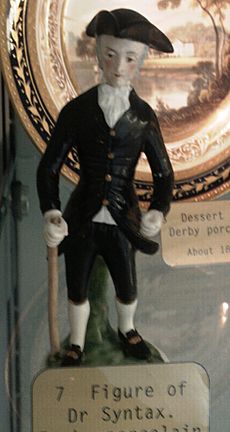William Combe facts for kids
William Combe (born March 25, 1742 – died June 19, 1823) was a British writer known for many different types of books. He lived an adventurous life when he was young. Later, he spent much of his time living within the "rules" of the King's Bench Prison, which meant he had to stay in a certain area because of debts.

Combe is best remembered for writing The Three Tours of Doctor Syntax. This was a funny poem that came with colorful pictures by the artist Thomas Rowlandson. The poem made fun of a writer named William Gilpin. Combe also wrote a series of made-up letters, pretending they were from the second Lord Lyttelton, who was known as "wicked." He also wrote similar letters between Swift and "Stella." Besides these, he wrote the text for many illustrated books and worked as a general writer for hire.

Contents
William Combe's Early Life
William Combe's father, Robert Combes, was a wealthy iron seller in Bristol. His father passed away in 1756. His mother, Susannah Hill, who came from a Quaker family, died earlier in 1748.
Combe went to Eton College, a famous school. After his father died, his guardian, William Alexander, took him out of school. Alexander also passed away in 1762. Combe inherited money from both his father and his guardian. He wanted to live like a gentleman and even changed his name to Combe. He spent all his money traveling and was even called "Count Combe." Between 1769 and 1773, he had very little money and lived in France, Wales, and the West Midlands area of England.
In 1773, a writer named Robert Berkeley hired Combe to help edit a book called Description of Patagonia by Thomas Falkner. After this, Combe settled down to work as a writer and book editor.
What Did William Combe Write?
In 1776, Combe became successful in London with his book The Diaboliad. This book was a satire, which means it used humor to criticize people. It contained very strong personal attacks.
Four years later, in 1780, Combe got into debt. This led him to the King's Bench Prison, a place where people who owed money had to stay. He spent much of his later life living within the rules of this prison.
Famous Fictional Letters
Combe wrote some fake letters called Letters of the Late Lord Lyttelton (1780). Many people at the time believed these letters were real. Even as late as 1851, a writer thought they were true. Combe also wrote anonymous letters called Letters supposed to have been written by Yorick and Eliza (1779). The characters Yorick and Eliza were from a famous book by Laurence Sterne.
Writing for Newspapers and Government
Combe wrote many different things, including pamphlets, satires, and funny stories. He wrote "two thousand columns for the papers" and "two hundred biographies." Around 1789, he was paid £200 each year by the government of William Pitt to write pamphlets.
The English Le Sage
In 1790 and 1791, Combe wrote six books called Devil on Two Sticks in England. These books earned him the nickname "the English le Sage," comparing him to a famous French writer.
In 1794, he secretly wrote the story for Aeneas Anderson's book about Lord Macartney's trip to China. This book was called "A Narrative of the British Embassy to China, in the Years 1792, 1793, and 1794." From 1794 to 1796, he wrote the text for Boydell's History of the River Thames. In 1803, he started writing for The Times newspaper.
The Doctor Syntax Series
From 1809 to 1811, Combe wrote a funny poem for Ackermann's The Poetical Magazine. This poem was called The Tour of Dr Syntax in Search of the Picturesque. It was a series of poems with pictures by Thomas Rowlandson. The poem made fun of William Gilpin, who traveled around Britain talking about his idea of "the Picturesque."

The first Doctor Syntax poem was put into a book in 1812. After that, Combe wrote two more similar stories: "...in search of Consolation" (1819) and "...in search of a Wife." In the first story, Mrs. Syntax dies. The second story became a book in 1820, and the third became a book in 1821. Later versions of these books sometimes had black and white pictures instead of color.
Other Works and Collaborations
Combe also wrote:
- Six Poems in illustration of drawings by Princess Elizabeth (1813)
- The English Dance of Death (1815–1816)
- The Dance of Life (1816–1817)
- The Adventures of Johnny Quae Genus (1822)
All these books were written to go with Thomas Rowlandson's funny drawings. Combe also wrote histories of Oxford and Cambridge universities, and of Westminster Abbey for a publisher named Ackermann. He wrote Picturesque Tours along the Rhine and other rivers, Histories of Madeira, Antiquities of York, and texts for Turner's Southern Coast Views. He also contributed countless articles to the Literary Repository.
William Combe passed away in London on June 19, 1823.
Translations of Doctor Syntax
The Doctor Syntax books were so popular that they were translated into several other languages:
- Doctor Syntaxes Reise at opsøge det Pittoreske, a Danish translation (1820)
- Le Don Quichotte Romantique, ou voyage du Docteur Syntaxe, a French translation (1821)
- Des Doktor Syntax Reise : ein Gedicht in 26 Gesängen nebst dreißig kolorirten Steinstichen ; Herausgegeben zum Besten der Königlichen Preußischen General-Post-Armen-Kasse. (1822)
- Die Reisen des Doctors Syntax. Dem Deutschen einverleibt von Wolf-Dieter Bach und mit ihm gemeinsam herausgegeben von Norbert Miller und Karl Riha. 2 volumes (1983)
- Doctor Syntax op zoek naar het pittoreske, a Dutch translation by Martin Hulsenboom (2015)


